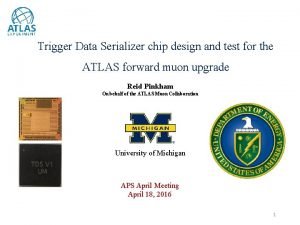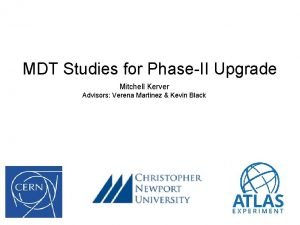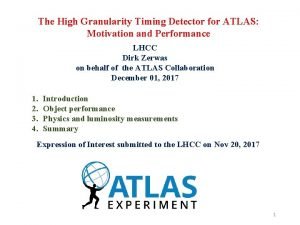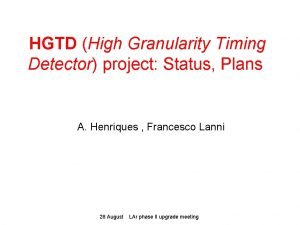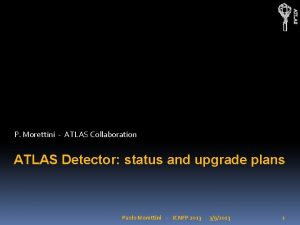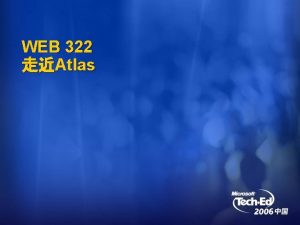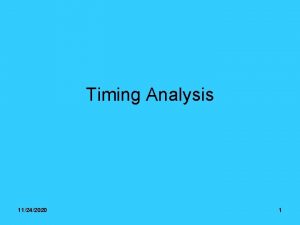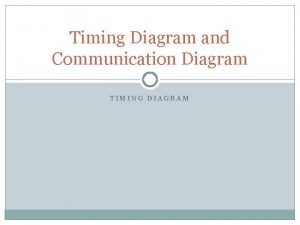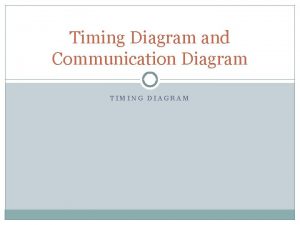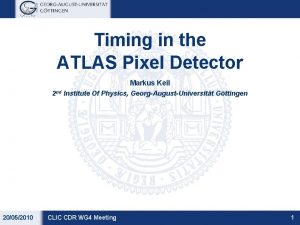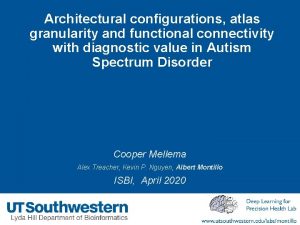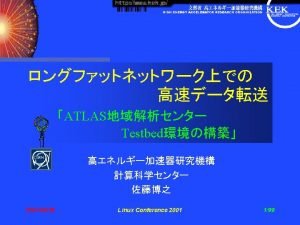The High Granularity Timing Detector for ATLAS Motivation














- Slides: 14

The High Granularity Timing Detector for ATLAS: Motivation and Performance LHCC Dirk Zerwas on behalf of the ATLAS Collaboration December 01, 2017 1. 2. 3. 4. Introduction Object performance Physics and luminosity measurements Summary Expression of Interest submitted to the LHCC on Nov 20, 2017 1

HL-LHC: The Challenge HL-LHC: • Pileup μ=200 • pileup density in 6 mm window: • Most probable: order 1. 6/mm • Tails up to 3/mm Track reconstruction: • z 0 resolution degraded as fct of eta • z 0 resolution degraded when p. T decreases 2. 4<η<4. 0 2 As a consequence and the hard scatter efficiency and the fwd electron ID are degraded

HL-LHC: The Challenge Beamspot: • z ~50 mm • t ~180 ps ITk+HGTD (Full Simulation): • HS Vertex • Reconstructed vertices • Track(s) p. T>1 Ge. V in HGTD • no track p. T>1 Ge. V in HGTD • No track p. T>1 Ge. V • Track(s) p. T>1 Ge. V in HGTD (order 50%) 3

Tracking and Timing Separation in • z through ITk • t through HGTD 4

High Granularity Timing Detector • • z=3500 mm 2 -4 Layers • • η>2. 4 (R=640 mm) η<4. 0 (R=120 mm) 30 ps per track over the lifetime of HL-LHC 5 Granularity: 1. 3 mm x 1. 3 mm

Jets • Reject pileup jets • • • ratio tracks/Jet PT small for pileup jets HGTD timing to remove pileup tracks Jets • At PU=2%: HGTD improves fwd performance to barrel level • Gain a factor 4 in rejection for HS 60% with 30 ps per track at «low» jet p. T (most difficult region) 6

B-tagging Fwd B-tagging: • Pileup contamination of tracks associated to jets • Timing rejects pileup tracks • Fwd performance improved almost to barrel level At 70% efficiency with a 30 ps timing resolution per track improvement by factor 1. 8 • 7

Electrons Electron isolation: • Pileup tracks in ID cone • ITk less efficient at high pileup densities • HGTD: Improvement to 95% HGTD for electrons (Full simulation): • Small impact in barrel • Large impact in HGTD acceptance • Same level as barrel • Independent of pileup density • 30 ps per track • At 1. 6 vertices/mm: 13% improvement 2. 4<η<4. 0 8

Physics channels (examples) VBF: qq. H→qq. WW* → qq eνμν: • BDT • 43% bg reduction • dominated by top background rejection (fwd b -tagging) • 3% pileup rejection • Relative improvement: 8% (0. 088 wrt 0. 096) t. H with H to bbar: Relative improvement: 11% (significance: 1. 42 wrt 1. 28) 9

Luminosity Order 1% error on luminosity measurement important for many physics analyses: • HGTD will provide 40 MHz bunch by bunch measurements Full simulation and reconstruction: • Truth vertices versus HGTD hits in an eta ring • Good linearity (fit low, extrapolate high) • Better than % stat error in 1 s 10

Summary The HL-LHC pileup density is a challenge which is mitigated with the HGTD for e. g. jets The HGTD: • Will add redundancy for pileup mitigation • Improve object reconstruction • Improve measurements eg VBF HWW, t. H • Precise luminosity measurement and e. g. b-tagging Several other applications being studied: • L 0/L 1 trigger • VBF →H →τ τ • Electron ID for: sin 2θW • Long Lived Particles • … 11

Occupancy (Full simulation): • < O(10%) • Pileup is radius dependent • Keep design simple • best timing resolution for small readout cells • Pixel size: 1. 3 mm x 1. 3 mm 12

Expected Timing Performance • • 99% coverage 97% track-hit matching efficiency • • • 30 ps per hit before irradiation 60 ps per hit after irradiation Fill-factor effect compensated by double hit: 32 ps-43 ps (after irradiation) 13

Electrons Electron isolation: • Pileup tracks in ID cone • ITk less efficient at high pileup densities • HGTD: Improvement to 95% 2. 4<η<4. 0 HGTD for electrons (Full simulation): • Small impact in barrel • Large impact in HGTD acceptance • Same level as barrel • Independent of pileup density • 30 ps per track • At 1. 6 vertices/mm: 13% improvement 14
 Symmetric shared memory architecture
Symmetric shared memory architecture Granularity data warehouse
Granularity data warehouse Txp100
Txp100 Atlas detector
Atlas detector Atlas motivation
Atlas motivation Mason high motivation
Mason high motivation Kontinuitetshantering i praktiken
Kontinuitetshantering i praktiken Novell typiska drag
Novell typiska drag Nationell inriktning för artificiell intelligens
Nationell inriktning för artificiell intelligens Returpilarna
Returpilarna Shingelfrisyren
Shingelfrisyren En lathund för arbete med kontinuitetshantering
En lathund för arbete med kontinuitetshantering Adressändring ideell förening
Adressändring ideell förening Tidbok för yrkesförare
Tidbok för yrkesförare Sura för anatom
Sura för anatom


